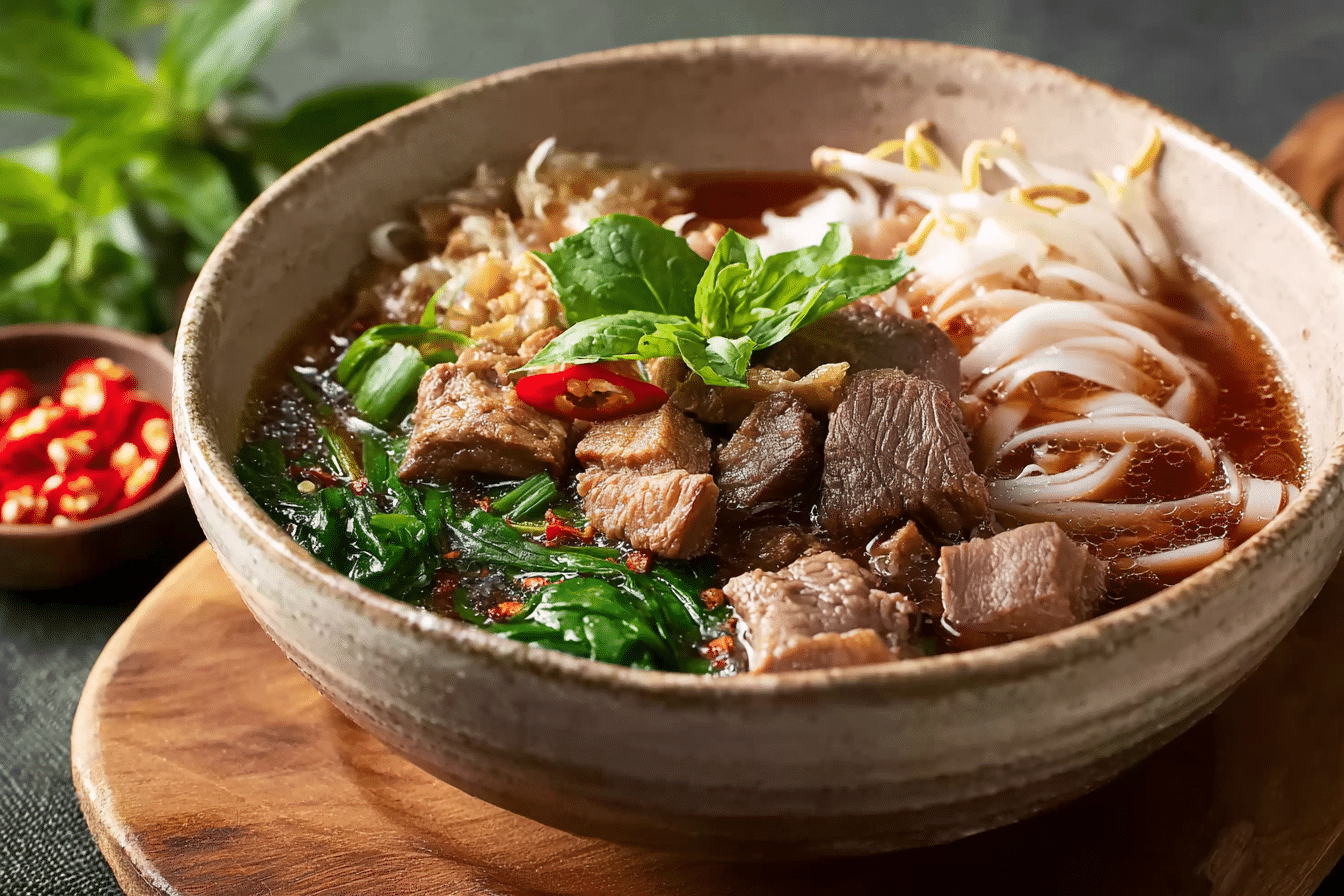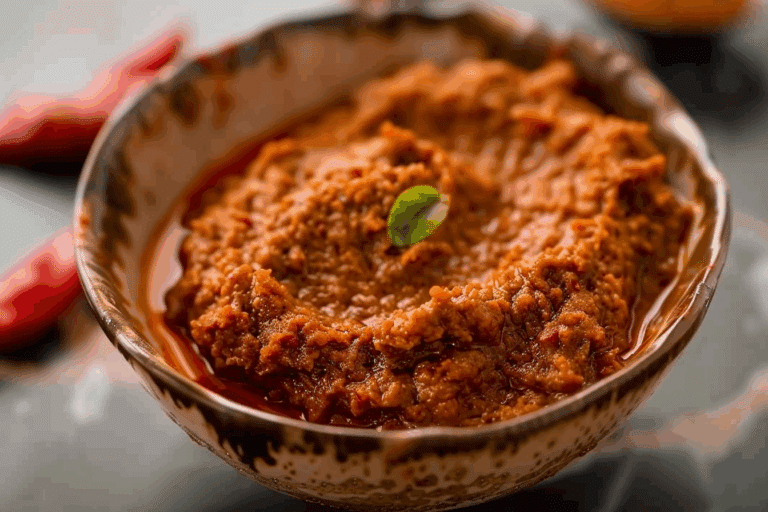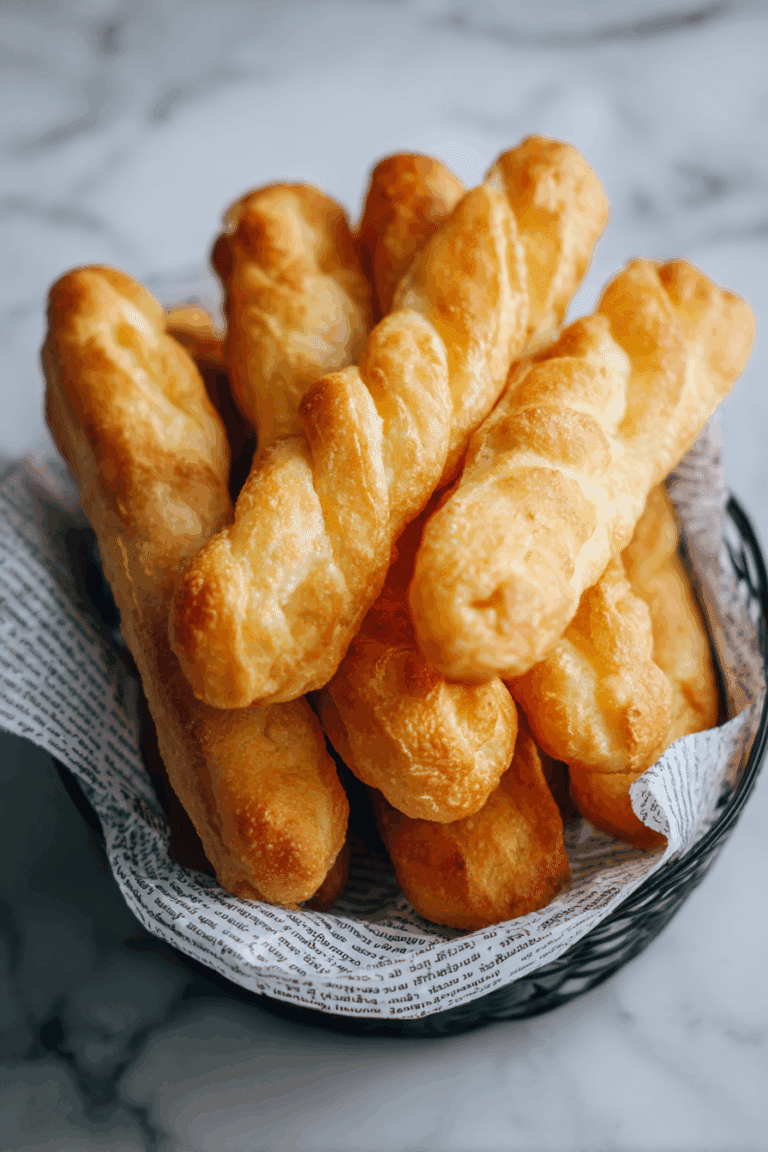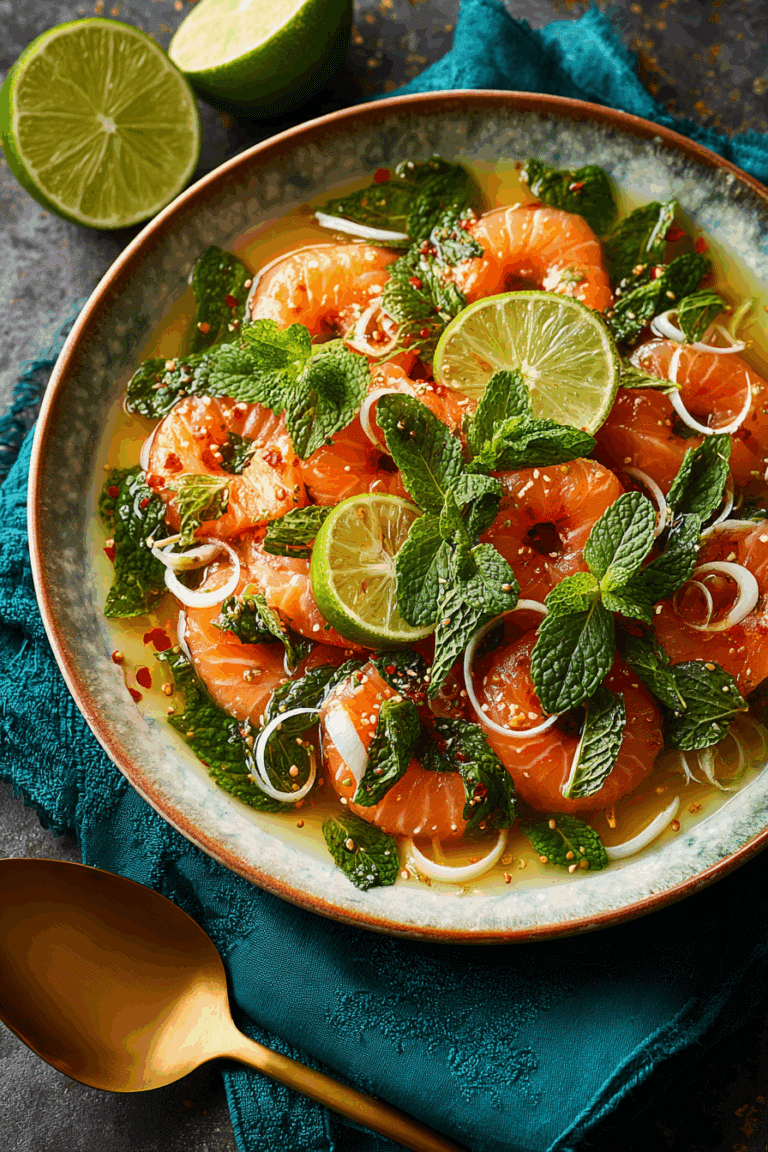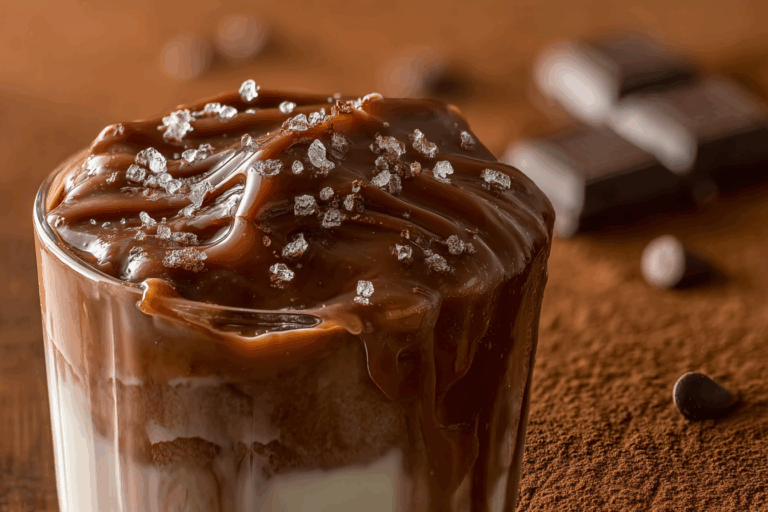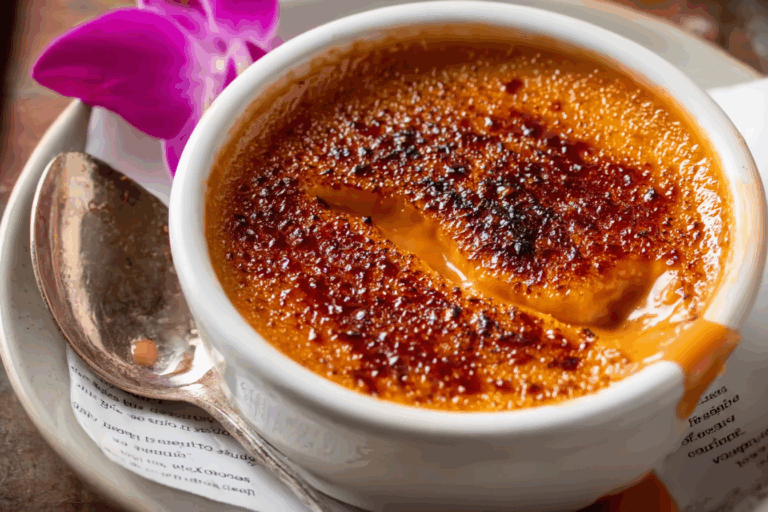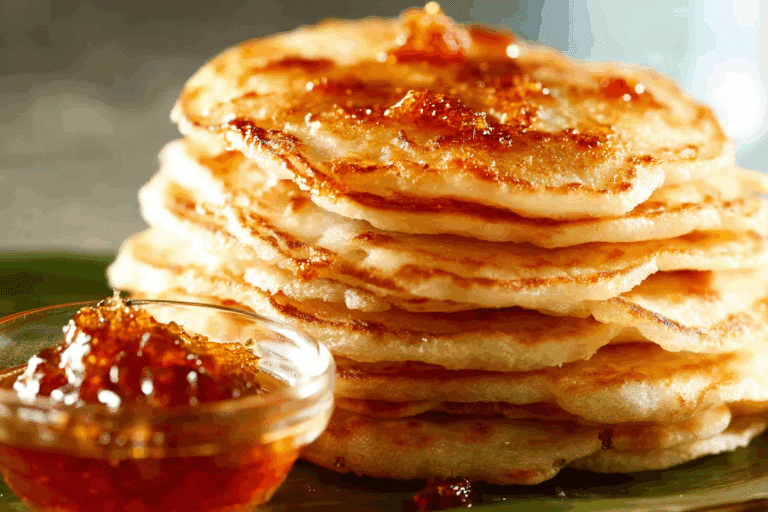Thai Boat Noodles with Beef: The Ultimate Guide
Thai Boat Noodles with Beef are one of the most flavorful, bold, and satisfying noodle soups in the entire Thai culinary landscape. At Just Thai Recipes, our journey into the heart of traditional Thai cooking began with a simple goal to bring authentic Thai flavors to home kitchens everywhere. As shared on our About Page, Lina’s story began in the bustling markets of Thailand, where she learned to cook from her grandmother using family recipes passed down for generations. Each bowl, each stir of a spoon, carries those memories into your home.
This iconic dish, once sold directly from wooden boats gliding through the canals of Bangkok, combines rich beef broth, tender meats, earthy spices, and fresh herbs in a way that feels both nostalgic and exciting. In this guide, we’ll explore the origins, cultural significance, ingredient breakdown, cooking method, and variations of Thai Boat Noodles with Beef. Whether you’re new to Thai cuisine or searching for the best way to replicate restaurant-level flavor at home, you’ll find everything you need here.
You’ll also get answers to common questions like What are boat noodles in Thai?, Why is it called boat noodle?, and Is Thai boat noodle halal?. Plus, you’ll learn about the growing popularity of this dish through terms like Thai Boat Noodles near me, Thong Smith boat noodles, and even Thai boat noodles calories as we break down everything you need to know.
Check out our Green Curry Fried Rice for another Thai favorite that pairs beautifully with boat noodles.
Table of Contents
Table of Contents
Understanding Thai Boat Noodles with Beef
Origins and Cultural Roots of Thai Boat Noodles with Beef
Thai Boat Noodles with Beef, or Kuai Tiao Ruea in Thai, originated during the early 20th century when small food vendors served meals from their boats along Bangkok’s intricate canal system. These boats were equipped with a pot of broth, noodles, a small charcoal stove, and basic ingredients. The vendor would cook and serve meals right from their narrow boat to customers sitting on docks.
The practicality of the dish shaped its portion size and bold flavor. Since cooking from a cramped space was limiting, vendors focused on creating intensely seasoned broths in small servings, ensuring customers could enjoy a quick, flavorful meal. This necessity birthed what is now one of Thailand’s most iconic street foods.
Over time, boat noodle shops moved from canals to street-side stalls and eventually into restaurants, yet the name and style remained unchanged. Thai boat noodles are often still served in small bowls, encouraging diners to order several rounds—just like in the old days.
Why it’s Called “Boat Noodles”
The name comes directly from its history. “Boat noodles” refers to the dish’s original method of delivery and preparation from boats. Unlike other noodle soups in Thai cuisine, boat noodles are known for their intensely rich and sometimes thick broth, which historically contained pig or cow blood as a thickening agent, giving it a distinct body and color. While modern recipes may skip this ingredient, the essence of a deeply umami-rich broth has remained unchanged.
Boat noodles were built for speed, portability, and satisfaction, making them a prime candidate for street food culture. Their strong taste also made them ideal for busy markets and bustling traffic along Thailand’s waterways.
Bangkok’s Street Food Culture and Boat Noodle Legacy
In Bangkok today, places like Victory Monument are famous for their alleyways filled with boat noodle vendors. Restaurants offer bowl after bowl in traditional mini servings so diners can sample multiple rounds. This way of eating is not just a meal; it’s a shared experience—fun, fast, and full of flavor.
Boat noodles are a culinary time capsule, offering a bite of history in each spoonful. They’re the type of dish that connects you to the heart of Thai food culture and tradition.
Now that you understand where this incredible Thai Boat Noodles with Beef comes from, let’s break down what makes it so unique in both flavor and construction.
Looking for more authentic flavors? Don’t miss our Thai Red Rubies Dessert for a sweet finish to your Thai meal.
Ingredients Breakdown For Thai Boat Noodles with Beef
Core Ingredients for Authentic Flavor of Thai Boat Noodles with Beef
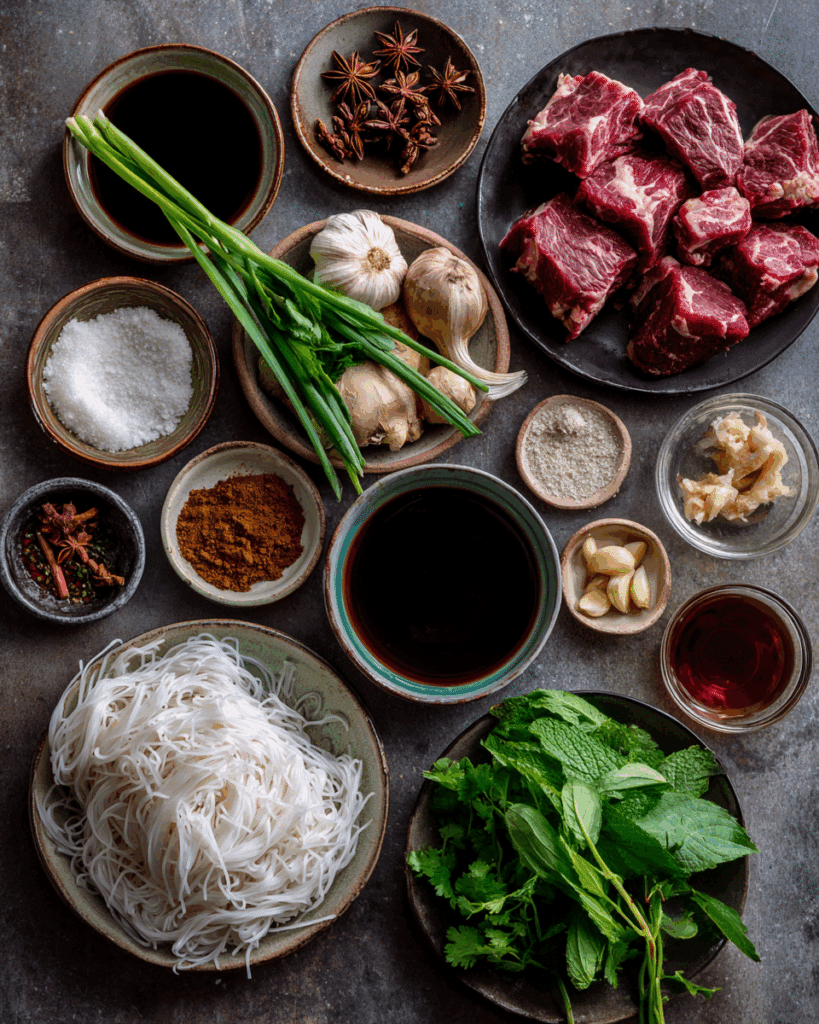
To make Thai Boat Noodles with Beef at home, it’s essential to understand the core components that give this dish its iconic depth. This is not your typical noodle soup. Every ingredient in the broth and toppings plays a crucial role in building layers of complex, umami-packed flavor.
Here’s a look at the main ingredients you’ll need:
Beef Bones: Use marrow or knuckle bones for a broth that’s naturally rich in collagen and flavor. These bones simmer for hours, releasing minerals and gelatin, creating the base of a hearty, beefy soup.
Beef Brisket or Shank: These cuts offer excellent texture and flavor after long, slow cooking. They become melt-in-your-mouth tender when simmered, perfect for adding meaty richness to your bowl.
Beef Sirloin: This tender cut is added last, just before serving. Thin slices of sirloin are flash-cooked in the hot broth, absorbing the spice-laden flavors instantly while staying juicy.
Garlic, Shallots, Ginger: These aromatics are sautéed at the beginning to build flavor. The combination enhances the earthy and spicy tones that make boat noodle broth so distinct.
Star Anise & Cinnamon Stick: These warm spices are essential. Star anise gives the soup its signature licorice-like aroma, while cinnamon balances the richness of the meat with a subtle sweetness.
Coriander Roots or Stems: This underrated ingredient adds a citrusy, peppery depth to the broth. If roots are unavailable, crushed stems work well too.
Soy Sauce, Dark Soy Sauce, Oyster Sauce: These sauces add layers of umami. Dark soy also gives the broth its darker color and a mild sweetness.
Fish Sauce: Adds saltiness and depth. Use it sparingly at first, then adjust to taste.
Palm Sugar or Brown Sugar: Palm sugar is traditional and adds subtle caramel notes. Brown sugar is a good substitute if needed.
Beef Stock or Water: If you’re short on time, a rich store-bought beef stock can speed things up. Otherwise, use water and let the bones do their job during the simmering process.
Want more tips on traditional ingredient use? Discover great ideas like Green Curry Fried Rice for more inspiration on combining proteins and spices.
Condiments and Garnishes that Define Thai Boat Noodles with Beef
Part of what makes Thai Boat Noodles unforgettable is how customizable they are. Once the broth and noodles are in place, toppings and condiments let you make each bowl your own.
Here are the essentials:
Bean Sprouts: These add crunch and freshness, balancing the richness of the broth.
Thai Basil: Brings a slightly sweet, peppery aroma that complements the beef beautifully.
Green Onions & Fresh Cilantro: These herbs enhance the soup’s aroma and offer a fresh bite with every spoonful.
Crispy Fried Garlic (Optional): While not required, this garnish adds a deep, savory crunch that elevates the dish.
Optional Condiments for Authentic Touch:
- Chili Flakes: Add heat and smoky depth.
- Pickled Chili in Vinegar: A traditional table condiment in Thai restaurants.
- Fish Sauce with Chopped Chilies: Adds heat and saltiness.
- White Sugar: A touch of sweetness can balance intense spice or saltiness.
Looking for another easy dish with classic Thai herbs and sauces? Try our Thai Pineapple Fried Rice for a quick stir-fry with rich tropical notes.
Step-by-Step Cooking Instructions Of Thai Boat Noodles with Beef
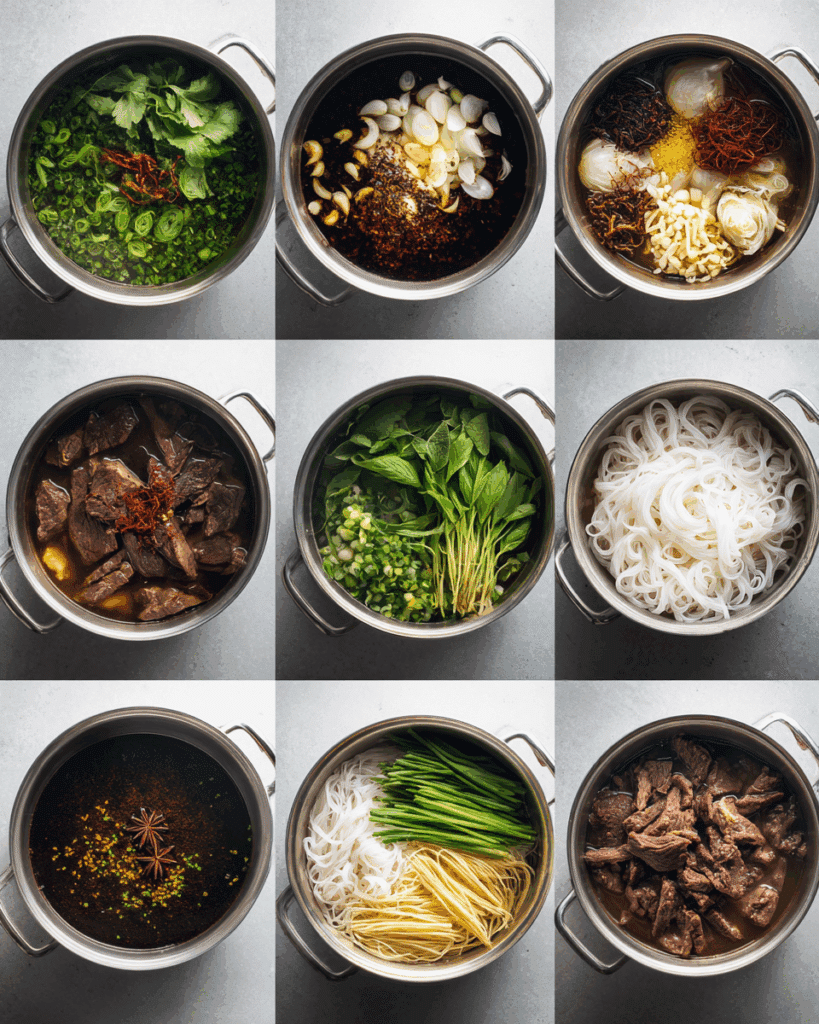
How to Prepare the Perfect Beef Broth
Creating the broth is the heart and soul of any Thai Boat Noodles with Beef recipe. A well-made broth should be rich, aromatic, slightly sweet, and layered with warm spices and savory depth. To achieve this, the cooking process is slow and steady, allowing every ingredient to release its full potential.
Step 1 – Sauté the Aromatics
In a large pot, heat two tablespoons of vegetable oil over medium heat. Add six smashed garlic cloves, two halved shallots, and a two-inch piece of sliced ginger. Sauté until everything becomes golden and fragrant. This forms the base of your broth’s flavor.
Step 2 – Add Spices
Toss in three star anise pods, one cinnamon stick, and two crushed coriander roots or stems. Stir gently for about 30 seconds to bloom the spices without burning them. This brings out their essential oils, which will infuse the broth beautifully.
Step 3 – Sear the Beef Bones and Brisket
Place two pounds of beef bones and one pound of beef brisket or shank (cut into chunks) into the pot. Sear them on all sides until browned. This browning adds caramelized depth to the broth.
Step 4 – Add Liquids and Seasoning
Pour in 8 cups of beef stock or water. Add 2 tablespoons soy sauce, 2 tablespoons dark soy sauce, 1 tablespoon oyster sauce, 1 tablespoon fish sauce, and 1 tablespoon of palm sugar (or brown sugar). Stir everything well.
Step 5 – Simmer and Skim
Bring the pot to a boil, then reduce to a low simmer. Skim any foam that rises to the surface to keep the broth clear. Let it simmer gently for 2 to 3 hours, or until the brisket is tender and the broth is deeply flavorful.
For a deeper dive into the broth-making process, don’t miss this step-by-step guide from Hot Thai Kitchen’s boat noodles recipe, where you’ll find insider tips from a Thai-born chef.
Assembling a Bowl like a Thai Street Vendor
Once the broth is done, assembling the perfect bowl of Thai Boat Noodles with Beef becomes an art of balance, timing, and layering.
Step 6 – Prepare the Rice Noodles
Cook one pound of fresh or dried rice noodles (medium width) according to the package instructions. Drain and rinse them under cold water to prevent sticking. Set aside until ready to serve.
Step 7 – Cook the Sirloin in the Broth
Thinly slice half a pound of beef sirloin. When you’re ready to serve, add these slices to the hot broth for 1 to 2 minutes—just long enough to cook them through. Remove quickly to avoid overcooking.
Step 8 – Build Each Bowl
In serving bowls, place a layer of cooked noodles. Add a few chunks of the brisket, a few slices of cooked sirloin, and a handful of bean sprouts. Then, ladle in the steaming hot broth.
Step 9 – Add Fresh Herbs and Garnishes
Top with Thai basil, sliced green onions, fresh cilantro, and crispy fried garlic (if using). Finally, set out a tray of optional condiments like chili flakes, vinegar-pickled chilies, and fish sauce with chopped chilies so guests can customize their bowls.
You can also learn more techniques and cooking secrets from this beautifully detailed post by Simply Suwanee, where family memories and flavor merge to bring Thai boat noodles to life.
For those interested in a more technical approach and deeper flavor science, Serious Eats offers a thorough breakdown of how to braise the beef and blend umami-rich components for a restaurant-quality result.
Whether you follow the traditional path or take a modern shortcut, the result should always be the same: bold, comforting, and unmistakably Thai.
Thai Boat Noodles with Beef Variations and Substitutes
Regional and Restaurant-Style Versions
Thai Boat Noodles with Beef may have started in the narrow canals of Bangkok, but the dish has evolved across Thailand and beyond, creating flavorful variations that reflect both regional ingredients and modern interpretations.
In central Thailand, especially around Bangkok, the broth tends to be deeply spiced and darker due to the use of dark soy sauce, star anise, and sometimes even cow or pig blood as a thickener. This traditional approach results in a soup that’s thick, rich, and robust in flavor. Often, these bowls are served in smaller portions, encouraging diners to order multiple rounds as part of the dining experience.
In northern Thailand, such as Chiang Mai, the flavors are often milder, and sometimes coconut milk is added for a creamier texture. The noodle type may also vary. While the Bangkok version uses medium-width rice noodles, in the north, you might find thin rice vermicelli or even egg noodles used to suit local taste.
As Thai cuisine became more global, restaurants began adapting the boat noodle formula for international palates. In the United States, for example, Thai boat noodles in restaurants are usually served in large portions, and the broth may be slightly lighter to appeal to a wider audience. Some places even add vegetables like Chinese broccoli or baby bok choy for extra color and nutrition.
Thong Smith boat noodles have gained popularity in upscale Thai food circles. Known for their polished presentation and concentrated broth, these versions maintain authenticity while incorporating premium cuts of beef and modern plating techniques. They’re a prime example of how traditional dishes can be elevated while preserving cultural integrity.
Every restaurant adds its own flair. Some use braised short ribs instead of brisket, while others offer boat noodles with pork, chicken, or even tofu. Yet, the soul of the dish remains unchanged — a balance of sweet, salty, spicy, and sour flavors all held together by a deeply satisfying broth.
Adapting Thai Boat Noodles with Beef at Home
Making Thai Boat Noodles with Beef at home doesn’t mean you have to follow every step to the letter. There are several shortcuts and substitutions that allow you to enjoy a delicious bowl even on a busy weeknight.
One common adaptation is using Thai boat noodles instant packs. These can be found in Asian supermarkets or online, and while they don’t match the richness of a long-simmered broth, they provide a fast, convenient option with decent flavor. Most instant versions include a flavor packet that mimics the spice blend of traditional broth.
Thai boat noodle soup paste is another helpful shortcut. This concentrated paste usually contains spices like cinnamon, star anise, garlic, and soy sauce. Add it to a store-bought beef broth, and you’ll have a deeply flavored base ready in minutes. If using paste, be mindful of salt content since it’s often highly seasoned.
For home cooks who want to avoid pork or are cooking for halal diets, beef-based recipes are ideal. By using certified halal beef and checking sauce ingredients for alcohol or hidden pork products, the dish can easily meet halal standards. You can also skip any optional additions like blood or fish sauce if preferred.
Vegetarian versions are becoming more popular too. Substituting mushroom broth for beef broth, and using firm tofu or seitan instead of meat, creates a plant-based alternative that still packs in flavor. Swap out fish sauce for soy sauce or mushroom soy, and load up on fresh herbs, sprouts, and spicy condiments to maintain the dish’s bold personality.
The noodle type is also flexible. Medium-width rice noodles are traditional, but you can experiment with thin rice sticks, flat pad Thai noodles, or even glass noodles depending on texture preference. Dried noodles are easy to store and work well with strong broths, while fresh noodles offer a softer, chewier bite.
With so many ways to adapt, Thai Boat Noodles with Beef can be as authentic or approachable as you want. Whether you’re cooking for a crowd or just for yourself, the flexibility of this dish ensures it never gets old.
Nutritional Insights
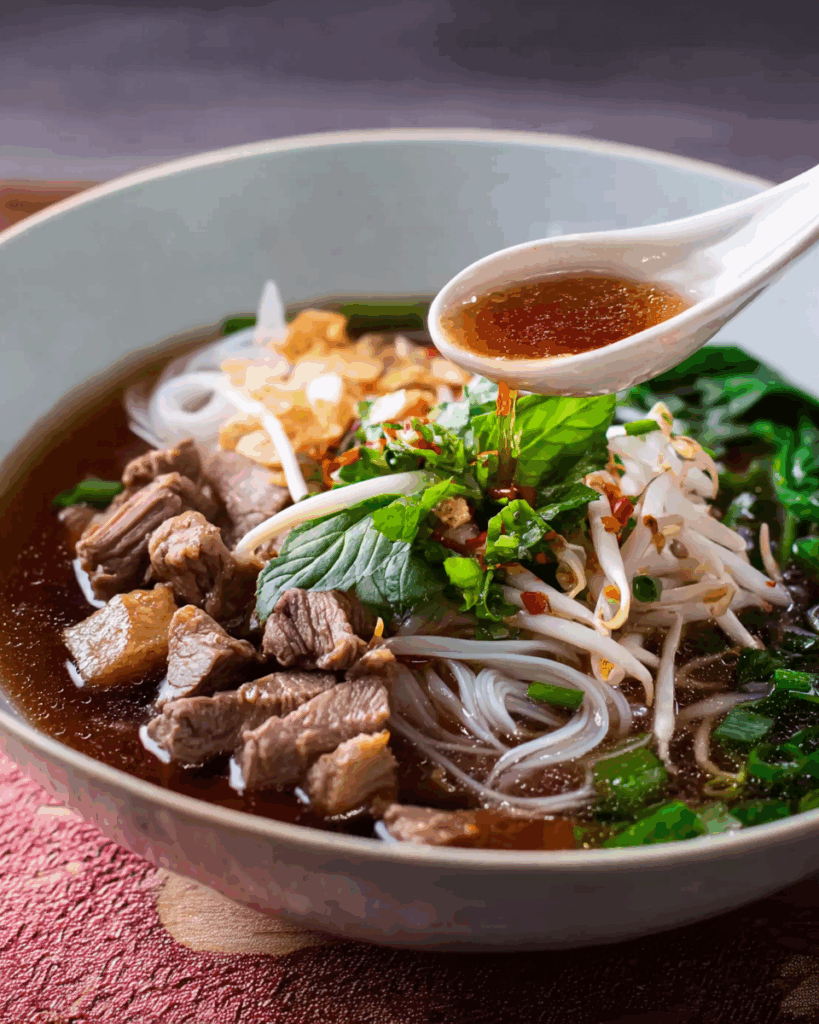
Thai Boat Noodles with Beef Calories and Macros
Understanding the nutritional breakdown of Thai Boat Noodles with Beef helps you enjoy this comforting dish with confidence. While it is rich in flavor and deeply satisfying, it’s possible to manage its calorie load and adapt it to your dietary goals.
On average, a full bowl of Thai boat noodles with beef contains between 550 to 650 calories. This includes the rice noodles, beef brisket and sirloin, the rich broth, and all the toppings such as bean sprouts, herbs, and crispy garlic.
The largest contributors to the calorie count are the beef and noodles. Beef brisket and sirloin, although protein-rich, also bring a fair amount of fat depending on the cut. Sirloin is leaner and contains about 150 calories per 4-ounce serving, while brisket is higher, averaging around 300 calories for the same portion. Rice noodles add roughly 190 to 220 calories per cup cooked.
The broth, though not heavy in volume, is made from simmered bones, oils, and sauces like dark soy and oyster sauce, all of which add to the total count. A well-seasoned broth made from scratch will include sodium, sugar, and some fat from the marrow and bones. For those watching sodium, it’s worth noting that soy sauce, fish sauce, and oyster sauce can collectively raise salt content significantly.
Fat content will vary based on how much bone marrow, beef fat, or oil is present. Most bowls have around 15 to 25 grams of fat, much of it from the beef and fried garlic garnish. Carbohydrates, mainly from the rice noodles and palm sugar in the broth, range between 40 to 55 grams per bowl. The protein content is solid thanks to the meat, typically delivering 25 to 35 grams per serving.
The toppings like fresh herbs and sprouts contribute vitamins, antioxidants, and fiber without many calories. Thai basil, cilantro, and bean sprouts are nutrient-dense yet very low in carbs and fats. These ingredients improve the overall nutritional profile and add a layer of freshness to balance the richness of the broth.
Balancing Flavor and Nutrition
Although Thai Boat Noodles with Beef is a hearty dish, there are several ways to make it more balanced without sacrificing taste.
To reduce sodium, consider using low-sodium soy sauce or cutting back on the amount of fish sauce in the broth. Another tip is to skip adding extra salt at the table and instead use fresh herbs and spices like chili flakes or lime juice to enhance flavor naturally.
When it comes to sugar, reducing the palm sugar by half or replacing it with a natural sweetener such as monk fruit or stevia is an option for those limiting sugar intake. Just keep in mind that palm sugar contributes to the broth’s deep caramel-like undertone, so don’t remove it entirely unless necessary.
If you’re aiming for a high-protein, lower-fat version, choose leaner cuts of beef like sirloin or round steak. You can also use less meat and add boiled egg whites or tofu to maintain protein levels with less saturated fat.
For the noodles, fresh medium-width rice noodles are traditional, but you can replace them with glass noodles, zucchini noodles, or konjac noodles for fewer carbs. These options absorb the broth well and hold their texture during serving.
It’s also possible to prepare a broth using a combination of beef stock and water to cut down on calories and fat while still keeping strong flavor if you add enough aromatics and simmer long enough.
Cooking techniques make a difference as well. Skimming off the fat that rises to the top during simmering is a simple way to reduce the overall fat content. Instead of frying garlic in oil, try dry-toasting it in a nonstick pan for a healthier crunchy topping.
Adding more greens such as bok choy, napa cabbage, or shredded carrots is another easy win. These vegetables enhance the visual appeal, add fiber, and make the dish feel more filling without heavily increasing calories.
Overall, Thai Boat Noodles with Beef can be a satisfying meal that fits into a variety of nutritional plans. Whether you’re looking to build muscle, manage calories, or just enjoy a warm and hearty Thai dish, thoughtful adjustments make it possible to enjoy every bite without compromise.
Serving and Pairing Ideas
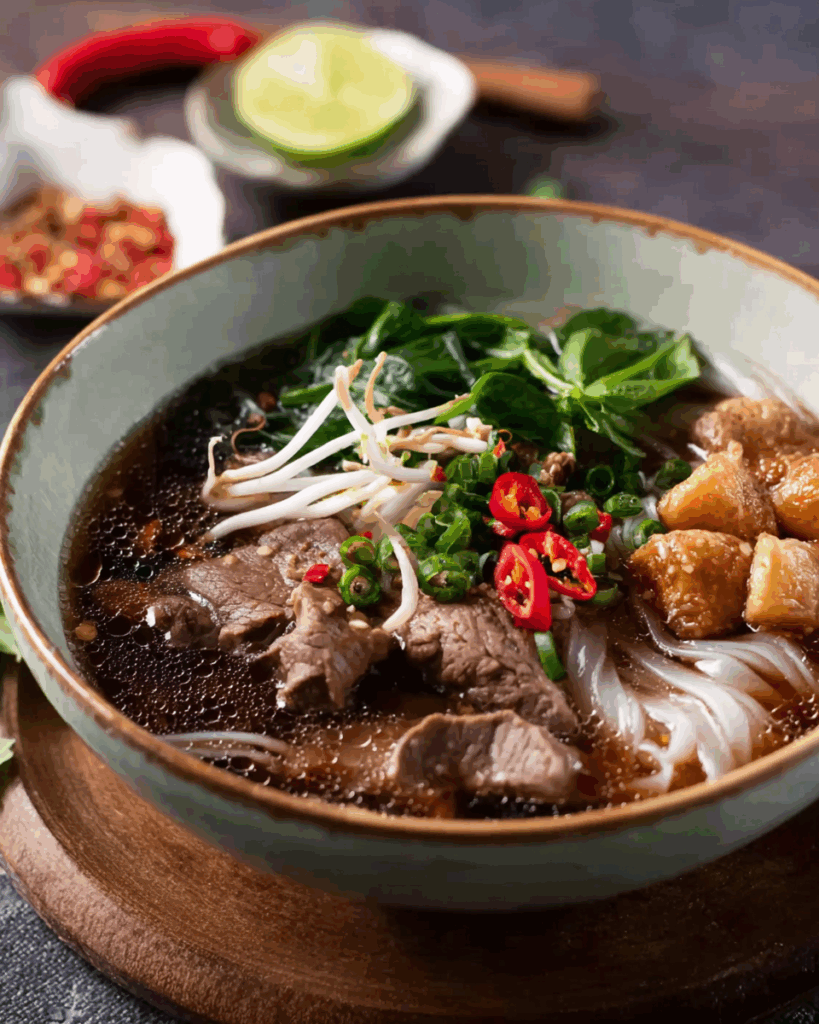
Side Dishes That Complement Thai Boat Noodles with Beef
While Thai Boat Noodles with Beef are bold and satisfying on their own, the right side dishes can turn a single bowl into a complete Thai-style feast. Balancing flavors and textures is key to creating a meal that feels well-rounded and deeply satisfying.
One of the most traditional pairings is a crunchy appetizer like fried spring rolls. These provide contrast with their crispy texture and mild, slightly sweet filling. The lightness of vegetables wrapped in delicate pastry complements the rich, beefy broth of the noodles perfectly. Serve with a simple sweet chili dipping sauce to enhance the experience.
Another excellent accompaniment is grilled Thai chicken, also known as gai yang. Thai Boat Noodles with Beef features marinated chicken pieces grilled over charcoal or on a stovetop grill pan. The smoky flavor and aromatic herbs in the marinade add a protein-rich side that echoes the spices in the noodle broth.
If you’re craving something lighter, a Thai green papaya salad can cleanse the palate and brighten the table. Made with shredded green papaya, chili, lime juice, fish sauce, and peanuts, this dish offers a sharp, tangy counterbalance to the deep, warming qualities of the soup. It also adds freshness and crunch that help cut through the richness of the beef broth.
Thai-style omelets served over rice are also a common accompaniment. These fluffy, golden eggs are usually cooked in hot oil, making the outside crispy while the inside remains soft and savory. A small wedge of this beside your noodles can bring comfort and balance to the meal.
Other side dish ideas include steamed jasmine rice with a fried egg, sticky rice with grilled meat skewers, or small bowls of sautéed morning glory with garlic and chili. Each dish contributes its own character while enhancing the core flavors of the boat noodles.
Creating a shared table experience with a few different side dishes allows guests to mix and match flavors at their own pace. This mirrors the communal and generous nature of traditional Thai dining and transforms a simple meal into a memorable occasion.
Beverages to Serve with Boat Noodles
With bold flavors and spicy notes present in Thai Boat Noodles with Beef, beverage pairings should aim to refresh the palate, cool the heat, and balance the meal.
Thai iced tea is one of the most iconic beverages to serve alongside boat noodles. Its sweet, creamy consistency made from strong black tea, condensed milk, and crushed ice is ideal for offsetting the savory spice of the broth. The rich sweetness of the tea also mirrors the subtle palm sugar notes in the soup, creating a flavor echo that feels intentional.
For a lighter option, consider fresh lime soda. Made with soda water, lime juice, and a touch of sugar syrup, this drink is fizzy and tart with just enough sweetness. It cuts through fat and refreshes the mouth between bites, making it especially useful when the broth is heavy or when chili heat builds.
Another excellent pairing is cold lemongrass tea. Brewed and chilled, this naturally sweet and citrusy drink has cooling properties that calm the tongue and soothe digestion. It’s also caffeine-free, which makes it a great choice for dinner or family gatherings where not everyone wants a stimulating drink.
If you prefer to serve alcohol, Thai boat noodles pair surprisingly well with beer. A light lager or pilsner can cleanse the palate and provide a refreshing contrast to the richness of the beef. Avoid dark beers, which may overpower the broth. Crisp white wines like Riesling or Sauvignon Blanc can also work well, especially if the soup leans heavily on herbal and spicy notes.
For non-alcoholic guests, consider coconut water served cold, or even a simple pitcher of ice water infused with cucumber and mint. These hydrating and mild options help cool the body and highlight the complexity of the dish without distraction.
Choosing the right beverage adds a layer of hospitality and thoughtfulness to the meal. Whether you’re serving a formal dinner or a casual get-together, pairing your boat noodles with a complementing drink brings harmony and satisfaction to every course.
Tips for Storing and Reheating
How to Store Leftover Thai Boat Noodles with Beef
When you’ve made a generous batch of Thai Boat Noodles with Beef, proper storage is essential to preserve flavor, texture, and safety. The components of the dish are best stored separately to maintain the quality of each part.
Start by separating the broth from the noodles and toppings. Thai Boat Noodles with Beef broth should be cooled completely before storage. Pour it into airtight containers, ideally glass jars or BPA-free plastic tubs. This prevents the broth from absorbing unwanted odors from the fridge and keeps the aromatic spices intact. Properly stored, the broth will last up to five days in the refrigerator.
The cooked noodles should be rinsed with cold water to remove any remaining starch before storing. Tossing them with a very light coating of oil can help prevent clumping. Place the noodles in their own airtight container, and they’ll stay fresh for two to three days. Avoid mixing them with the broth in the same container, as they will absorb the liquid and become mushy over time.
As for the toppings like sliced sirloin, brisket, bean sprouts, and herbs, store them in small separate containers. Brisket can be stored in the same container as the broth if desired, but the sirloin should be kept separately to prevent overcooking during reheating. Herbs and fresh toppings should be added only when serving, never stored in the broth, to avoid wilting and loss of texture.
The condiments, such as chili flakes or pickled chilies, should remain at room temperature if they are shelf-stable. However, if you’ve mixed fresh ingredients like chopped chili in vinegar or garlic in oil, keep them refrigerated and use them within one week.
Freezing is also an option, especially for the broth. Thai Boat Noodles with Beef broth freezes well for up to three months. Use freezer-safe containers and leave space at the top for expansion. When freezing cooked meat, wrap it tightly in foil or use vacuum-sealed bags to prevent freezer burn. Noodles do not freeze well and are best made fresh when ready to serve.
Proper storage of each element keeps your Thai Boat Noodles with Beef tasting as fresh as the day it was made, whether you’re meal-prepping or saving leftovers.
Reheating Without Losing Texture
Reheating Thai Boat Noodles with Beef requires attention to maintain the integrity of each component. The goal is to recreate the just-cooked taste and texture without overcooking or drying out the ingredients.
Begin by reheating the broth on the stovetop. Pour it into a saucepan and heat gently over medium-low heat until it begins to simmer. Avoid boiling it rapidly, as that can over-reduce the liquid and intensify the saltiness. Stir occasionally to ensure the spices are well distributed and the flavor remains balanced.
If the broth was frozen, thaw it in the refrigerator overnight or use a warm water bath to speed up the process. Once fully thawed, reheat as described above.
While the broth heats, prepare the noodles. If they’ve clumped together, run them briefly under warm water and gently separate them with your fingers or chopsticks. Place the noodles in a bowl and cover with hot water for a minute or two, then drain. This process rehydrates the noodles and restores their soft, chewy texture.
To reheat the beef brisket, you can let it warm directly in the hot broth just before serving. For sliced sirloin, avoid putting it in the pot while reheating the broth. Instead, place the raw or partially cooked slices directly into each serving bowl, then pour the hot broth over them. The heat of the liquid will cook the meat just enough, keeping it tender and juicy.
Add the bean sprouts, herbs, and any condiments just before serving. These elements should never be reheated, as their texture and flavor are meant to be enjoyed fresh. Thai basil, in particular, loses its aroma quickly when overcooked, so it’s best added raw.
For microwave reheating, use a deep bowl and follow a similar process. Reheat the broth first, then combine with noodles and meat in a separate bowl just before serving. Avoid microwaving everything together at once, which leads to overcooked noodles and rubbery beef.
With the right reheating approach, leftover Thai Boat Noodles with Beef can be just as enjoyable the next day. Proper separation, gentle warming, and thoughtful assembly are key to reviving all the bold flavors and textures of this beloved Thai dish.
Common Mistakes to Avoid
Cooking Errors That Ruin Thai Boat Noodles with Beef
When preparing Thai Boat Noodles with Beef, the details matter. While the recipe is straightforward at its core, there are several common mistakes that can result in a flat or unbalanced dish. Paying attention to technique and ingredients can mean the difference between a bland bowl and an unforgettable experience.
One of the most frequent errors is overcooking the beef sirloin. This cut is meant to be tender, lightly cooked, and juicy. When it’s boiled too long in the broth or added too early, it becomes tough and loses its delicate texture. To prevent this, always add the thin slices of sirloin at the very end and pour hot broth over them just before serving. The heat from the broth is more than enough to cook the meat perfectly.
Another mistake is using a weak or under-simmered broth. The essence of Thai Boat Noodles with Beef lies in its deeply flavored, aromatic soup. Cutting corners by simmering the broth for only 30 or 40 minutes won’t extract enough flavor from the beef bones, star anise, and herbs. A full two to three hours of gentle simmering is required to release the richness and build complexity. Rushing the broth will result in a watery, one-dimensional base that can’t support the rest of the dish.
Skipping the aromatic sauté is another critical misstep. The first step of frying garlic, shallots, and ginger before adding the bones is essential. This step builds the base flavor and allows the spices to bloom. Omitting it leads to a dull broth that lacks depth.
Some home cooks also forget to skim the foam that forms on top of the broth during simmering. This foam, if left in, gives the broth a cloudy appearance and can impart a bitter taste. Skimming ensures clarity, cleanliness, and a more polished final product.
Using too much or too little seasoning is also a problem. Thai Boat Noodles with Beef are meant to balance salty, sweet, spicy, and umami elements. It’s important to taste and adjust the broth as it cooks. Adding too much fish sauce can make it overly salty, while skipping palm sugar removes the subtle sweetness that rounds out the spices. The best approach is to start light and build flavor slowly, adjusting based on taste and aroma.
Neglecting the importance of condiments and garnishes is a final but serious error. The dish isn’t complete without the contrast provided by fresh herbs, bean sprouts, chili flakes, or pickled chilies. These toppings add brightness and heat, lifting the broth and enhancing every bite. Leaving them out means missing the soul of Thai street food culture.
Ingredient Substitutions That Work (and Don’t)
Adapting Thai Boat Noodles with Beef to fit your kitchen or diet is possible, but not all substitutions are equal. Knowing which swaps maintain authenticity—and which ones compromise flavor—can help you avoid disappointment.
For example, replacing palm sugar with white sugar is a common substitution. While white sugar adds sweetness, it lacks the caramel notes of palm sugar. If palm sugar is unavailable, brown sugar is a closer match and keeps the broth’s depth intact. Avoid artificial sweeteners unless you’re specifically aiming for a sugar-free version, as they can clash with the other bold ingredients.
If coriander root is unavailable, the stems can be used, but the leaves alone won’t give the same earthy flavor. Coriander root is peppery and citrusy, critical to the broth’s aroma. When substituting, crush the stems well to release their oils, and use more than the root version.
Another mistake is swapping dark soy sauce for regular soy sauce. Dark soy sauce adds both color and a slightly sweet, molasses-like depth. Regular soy sauce lacks this intensity and will result in a broth that is too light in flavor and color. If you must substitute, add a drop of molasses or brown sugar with light soy sauce to mimic dark soy’s profile.
As for the protein, it’s acceptable to substitute beef brisket with short ribs, shank, or even oxtail. These cuts also break down beautifully during long simmering. However, substituting with chicken or pork will change the character of the dish entirely. While you can make a poultry-based version, it will no longer capture the essence of Thai Boat Noodles with Beef, which relies heavily on rich red meat flavors.
Using the wrong noodles is also a misstep. Thin vermicelli or egg noodles don’t absorb broth in the same way as medium-width rice noodles. Stick to fresh or dried rice noodles for the best result. Their texture and thickness perfectly hold the broth and allow for even seasoning.
Lastly, using low-quality sauces or skipping fish sauce entirely can reduce authenticity. Fish sauce provides a key layer of saltiness and umami. While vegetarians might use mushroom soy or tamari as a substitute, meat-based recipes should include a good-quality Thai fish sauce for the most authentic taste.
Avoiding these mistakes ensures that your Thai Boat Noodles with Beef deliver not just warmth and comfort but also a true representation of one of Thailand’s most beloved street foods. Mastering the details lets the dish shine the way it’s meant to—full of flavor, deeply satisfying, and unmistakably Thai.
Conclusion
Thai Boat Noodles with Beef are more than just a comforting bowl of noodle soup. They are a story of Thai culture, tradition, and culinary excellence passed down from floating markets to modern kitchens around the world. From their humble beginnings served by boat vendors to their celebrated presence in contemporary Thai restaurants, this dish has earned a permanent place in the hearts of food lovers.
Making Thai Boat Noodles with Beef at home allows you to appreciate its complexity while customizing it to your taste and dietary needs. The deeply flavored broth, created from hours of simmering beef bones and spices, delivers richness in every spoonful. Combined with tender slices of sirloin, soft rice noodles, and a mix of fresh herbs and bold condiments, this dish becomes a full sensory experience.
The versatility of Thai Boat Noodles with Beef is another reason for its popularity. You can adjust the ingredients, control the spice, and choose the toppings that suit your preferences without losing the essence of the dish. Whether you’re preparing it for family, impressing guests, or simply treating yourself, every bowl brings a taste of Thailand to your table.
Throughout this guide, we’ve covered everything you need to create an authentic version of Thai Boat Noodles with Beef. From understanding its origin to preparing the broth, assembling the bowls, storing leftovers, and reheating them correctly, you now have a complete foundation to enjoy this dish confidently and deliciously.
Thai Boat Noodles with Beef represent the perfect balance of flavor, heritage, and comfort. With a little preparation and the right ingredients, anyone can master this classic Thai noodle soup at home. Whether it’s your first time making it or your fiftieth, each bowl is a celebration of bold flavors and time-honored techniques.
If you’re craving something bold, hearty, and undeniably satisfying, Thai Boat Noodles with Beef should be your next dish to master. It’s not just a recipe — it’s an invitation to experience the heart of Thai cooking in the most delicious way possible.
FAQs on Thai Boat Noodles with Beef
Is Thai boat noodle halal?
Thai Boat Noodles with Beef can be halal, but it depends entirely on how they are prepared. Traditional versions sometimes include pork or even a small amount of pig’s blood, which is used to thicken the broth and enhance its richness. These ingredients would not be permissible in a halal diet.
However, many modern versions of Thai Boat Noodles with Beef are made exclusively with halal-certified beef and skip any non-halal components. By using only beef bones, brisket, and sirloin, and ensuring that all sauces and seasonings are free from alcohol or pork derivatives, the dish can meet halal standards.
For those following a halal diet, it’s always best to prepare Thai Boat Noodles with Beef at home or confirm ingredients with the restaurant. When made with halal ingredients, this dish remains just as flavorful and satisfying. The depth of the broth, the tender meat, and the balance of spices all come from the careful cooking process and the right blend of aromatics — not from non-halal additions.
Thai Boat Noodles with Beef are adaptable and inclusive, making them a fantastic choice for diverse dietary needs without compromising the traditional taste and quality.
What do boat noodles taste like?
Thai Boat Noodles with Beef are known for their intense, multi-layered flavor profile. The broth is rich, savory, slightly sweet, and deeply spiced. Key ingredients like star anise, cinnamon, garlic, ginger, and coriander root give the soup its signature aroma and warmth. Soy sauce and fish sauce provide saltiness and umami, while palm sugar balances everything with a subtle sweetness.
The beef bones and brisket simmer for hours, releasing gelatin and minerals that make the broth almost velvety in texture. When combined with slices of tender sirloin, fresh herbs, bean sprouts, and chili condiments, the result is a bowl of noodles that tastes bold, balanced, and comforting. Every bite delivers depth and richness, followed by bright notes from the garnishes.
Unlike lighter noodle soups, Thai Boat Noodles with Beef are intentionally hearty and full-bodied. They’re meant to leave a lasting impression and satisfy even the most intense cravings for something savory and soul-warming.
Why is it called boat noodle?
The name boat noodle comes from the dish’s original method of preparation and serving. In the past, vendors on Thailand’s canals would paddle small boats equipped with all the necessary tools to cook and serve noodles to people onshore. This floating kitchen setup was compact and efficient. The broth used in Thai Boat Noodles with Beef had to be strong and concentrated so that it retained its bold flavor even when served in tiny bowls.
These small servings made it easy for boat vendors to handle orders without tipping their boats. Customers often ordered multiple bowls in one sitting, a custom that still lives on today in some noodle shops where boat noodles are served in stacks of tiny bowls. Thai Boat Noodles with Beef carry this name as a tribute to the tradition, even though they’re now often made in large batches and served on solid ground.
What are boat noodles in Thai?
Boat noodles in Thai are called Kuai Tiao Ruea. This dish originated from the traditional floating markets in Thailand, where vendors would prepare and sell noodles directly from their small boats. These noodles are not just about convenience — they are a deep part of Thai culinary heritage. Thai Boat Noodles with Beef, specifically, represent the beef-based version of this classic, known for its aromatic broth, tender meats, and rich, savory taste. The original recipe was crafted to be strong and bold in flavor, making it easy to enjoy in small portions quickly served to dockside customers.
Over time, Thai Boat Noodles with Beef have evolved from a street-side snack into a full meal served at restaurants and homes alike. They’re made with a unique blend of herbs, spices, and beef bones that simmer together for hours. The result is a broth that’s not just food but an experience in Thai cooking traditions.
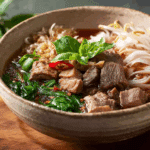
Thai Boat Noodles with Beef
- Prep Time: 20 minutes
- Cook Time: 3 hours
- Total Time: 3 hours 20 minutes
- Yield: 4 servings 1x
- Category: Main Course
- Method: Simmering
- Cuisine: Thai
- Diet: Halal
Description
Thai Boat Noodles with Beef feature a bold, spiced broth made from beef bones, star anise, cinnamon, and Thai aromatics. Tender beef brisket and sirloin are layered over rice noodles and topped with herbs, making this dish a deeply satisfying representation of traditional Thai street food.
Ingredients
- 2 lbs beef bones (marrow or knuckle preferred)
- 1 lb beef brisket or shank, cut into chunks
- 2 tbsp vegetable oil
- 6 cloves garlic, smashed
- 2 shallots, halved
- 1 piece ginger (2 inches), sliced
- 3 star anise pods
- 1 cinnamon stick
- 2 coriander roots (or stems), washed and crushed
- 2 tbsp soy sauce
- 2 tbsp dark soy sauce
- 1 tbsp oyster sauce
- 1 tbsp fish sauce
- 1 tbsp palm sugar (or brown sugar)
- 8 cups beef stock or water
- 1 lb fresh or dried rice noodles (medium width)
- 1/2 lb beef sirloin, thinly sliced
- 1 cup bean sprouts
- 1/2 cup Thai basil leaves
- 2 green onions, sliced
- 1/2 cup fresh cilantro leaves
- Crispy fried garlic (optional)
- Chili flakes (optional)
- Pickled chili in vinegar (optional)
- Fish sauce with chopped chilies (optional)
- White sugar (optional)
Instructions
- Heat vegetable oil in a large pot. Add garlic, shallots, and ginger; sauté until fragrant.
- Add star anise, cinnamon stick, and coriander roots; stir briefly to release their aroma.
- Add beef bones and brisket. Sear lightly on all sides.
- Pour in beef stock or water. Add soy sauce, dark soy sauce, oyster sauce, fish sauce, and palm sugar.
- Bring to a boil, then skim off any foam. Reduce heat and let it simmer for 2 to 3 hours until broth is rich and beef is tender.
- While broth simmers, cook rice noodles according to package instructions. Drain and rinse under cold water to prevent sticking.
- When ready to serve, add thinly sliced sirloin to the hot broth for 1 to 2 minutes until just cooked.
- Place noodles in bowls. Add brisket, sirloin, bean sprouts, basil, green onions, and cilantro.
- Ladle the hot broth over each bowl to warm and flavor the ingredients.
- Garnish with crispy fried garlic if using. Serve with chili flakes, pickled chili, fish sauce, and sugar so everyone can season to taste.
Notes
- Authentic boat noodles traditionally include pork or beef blood, but this is optional for home versions.
- Use marrow bones for a more intense and gelatinous broth.
- Roasting the bones and aromatics before simmering enhances the flavor depth.
- The broth can be made ahead and stored or frozen for quick meals.
- Adjust the spice level by controlling how much chili condiment is added at the table.
Nutrition
- Serving Size: 1 bowl
- Calories: 600
- Sugar: 8g
- Sodium: 1350mg
- Fat: 22g
- Saturated Fat: 8g
- Unsaturated Fat: 12g
- Trans Fat: 0g
- Carbohydrates: 50g
- Fiber: 3g
- Protein: 35g
- Cholesterol: 75mg
Keywords: Thai Boat Noodles with Beef, Thai beef noodle soup, boat noodles recipe, Thai street food soup, Thai beef broth noodles

